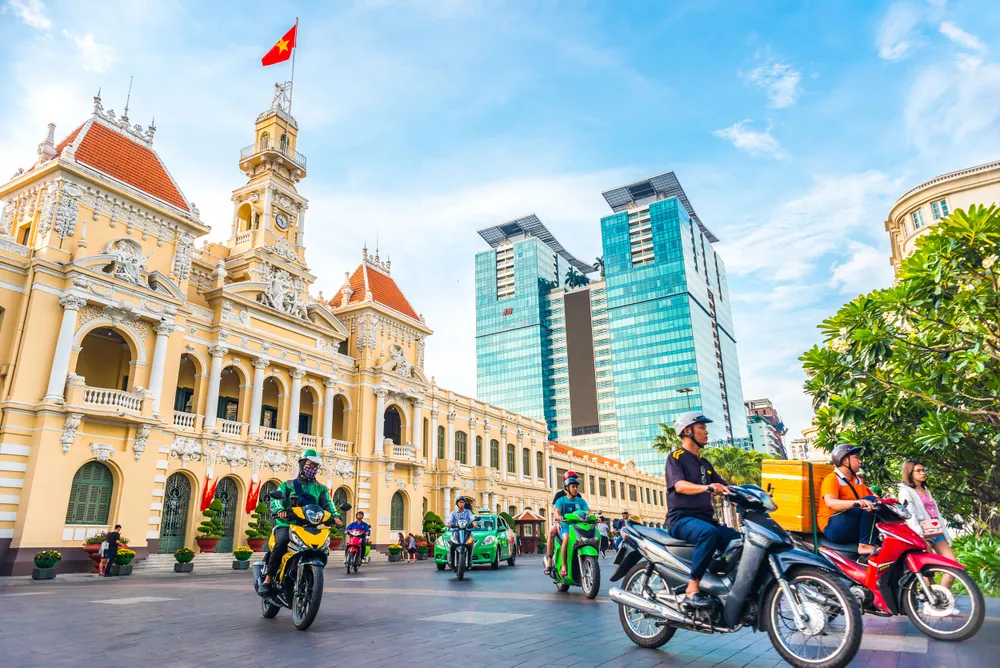
Gradual Growth, but Stability Elusive
In the first half of 2024, Ho Chi Minh City’s Gross Regional Domestic Product (GRDP) exhibited signs of recovery. The city’s GRDP is estimated to have reached VND 568,000 billion, marking a 6.46% increase compared to the same period last year. This growth, though promising, remains tenuous. The first quarter of 2024 saw a 6.54% rise in GRDP, largely driven by the service, industry, and construction sectors. However, this uptick reflects a rebound from a low base, making the growth appear more substantial than it might be in a more stable context. In the second quarter, GRDP increased by 6.31% year-on-year, continuing to be led by the same sectors but building on a higher base, indicating that the recovery is not yet robust.
The recovery in Ho Chi Minh City’s economy is largely underpinned by a revival in consumption and exports. However, consumption has been slow to return to pre-pandemic levels, as residents remain cautious amidst ongoing economic uncertainties. This trend is indicative of a precautionary savings mentality, where people prefer to save rather than spend due to the volatile macroeconomic environment.
Exports, a crucial component of the city’s economy, have shown some growth, with an estimated value of USD 20.6 billion in the first half of 2024, a 3.1% increase compared to the same period last year. However, this growth pales in comparison to the export figures seen during 2019-2022, signaling that the city’s businesses have not fully capitalized on the global economic recovery. The report points to missed opportunities, particularly in major export markets like China and the United States, which could have driven a more significant recovery.
One of the most pressing concerns highlighted in the report is the slow disbursement of public investment capital. In the first six months of 2024, only VND 10,900 billion was disbursed, a 29% decrease compared to the same period in 2023. This figure represents just 13.8% of the total capital planned for the year. The sluggish pace of public investment has hampered the growth of the construction sector, which remains modest despite the city’s ambitious infrastructure projects.
Moreover, the city has seen a worrying trend where large-scale enterprises are exiting the market at a greater rate than smaller enterprises are entering. This shift suggests a broader structural issue within the economy, where the challenges of doing business in the city are outweighing the benefits for larger firms.
Ho Chi Minh City’s role as Vietnam’s economic center is increasingly being challenged. According to Mr. Võ Văn Hoan, Vice Chairman of the Ho Chi Minh City People's Committee, the city’s economy, while recovering, has not regained the strength and stability it enjoyed before the pandemic. Compounding this issue is the growing competition from other provinces, both neighboring and more distant, which are attracting investors with cheaper land, lower costs, and greater opportunities.
The city’s economic future is further complicated by the demands of bilateral and multilateral free trade agreements. These agreements, while opening up new opportunities, also impose stringent technical barriers, particularly in areas such as green growth, environmental standards, and renewable energy. Without adapting to these new requirements, Ho Chi Minh City risks being left behind in the race to capture global market share.
Strategies for Sustainable Growth
Ho Chi Minh City has recognized the need for strategic shifts in its development approach. The city is beginning to focus on green transformation and digital technology as key drivers of future growth. The industrial sector, traditionally reliant on capital and labor-intensive industries, is gradually being reoriented towards high-tech industries that align with sustainable development goals. Similarly, the service sector is evolving to prioritize services that add value and meet the demands of a modern, digital economy.
However, these strategies are still in their infancy and have yet to be fully implemented. The challenge for the city will be to turn these orientations into practical, actionable plans that can drive long-term growth.
The economic outlook for Ho Chi Minh City in the latter half of 2024 is closely tied to the global economic environment. As the world economy continues its gradual recovery, Ho Chi Minh City’s export activities are expected to benefit, particularly from its two major markets, the United States and China. This export-driven growth will be crucial in sustaining the recovery of aggregate demand for goods and services within the city.
However, domestic enterprises in Ho Chi Minh City face significant challenges. Investment growth in the city is lagging behind the national average, and with bad debt remaining high and lending interest rates on the rise, businesses are likely to encounter difficulties. Dr. Hồ Hoàng Anh from the Ho Chi Minh City University of Economics stresses the need for the city to continue and expand discount promotion programs to stimulate consumer spending. These initiatives, if effectively organized, could provide much-needed support to local enterprises.
On the export front, it is essential for the city to conduct a detailed assessment of its export activities and swiftly implement support programs to maximize the opportunities presented by the global market recovery. Public investment disbursement must also be accelerated, particularly for key projects that can reduce production and business costs, enhance profitability, and stimulate private and foreign direct investment.
While Ho Chi Minh City’s economy is on the path to recovery, it is far from stable. The city faces a delicate balancing act, needing to foster growth while addressing structural weaknesses and adapting to a rapidly changing global economic landscape. The next six months will be crucial in determining whether Ho Chi Minh City can overcome these challenges and secure a sustainable recovery that benefits all its residents.




















